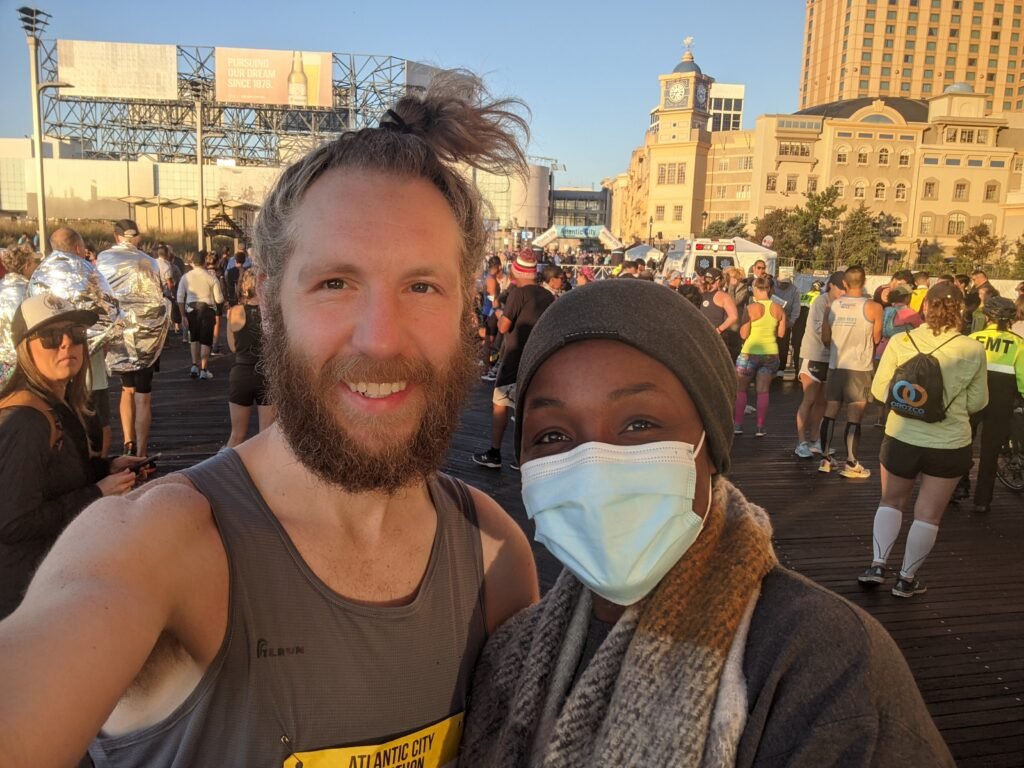When are you ready to run your first marathon?
That depends a little bit on what your expectations are.
You can run a marathon with very little training. But it probably won’t be enjoyable.
The more prepared you are – with months of running and mileage under your belt – the better your experience will be.
Below, I’ll share some advice from the most popular running coaches in the marathon training business. Then, I’ll let you know when I felt like I was ready to run my first marathon.
Why Shouldn’t You Just Rush Into Training for a Marathon?
In their 1979 book, Target 26, Skip Brown and John Graham had the following to say about the influx of new runners into marathoning:
[T]he thousands of newly arrived joggers try to reap these wondrous benefits by quickly aiming at that “ultimate experience,” the marathon. This is unfortunate.
Under pressure from the media, following the now fashionable sport, thousands of ill-prepared runners are attempting to run 26 miles 385 yards with very little conception of what that entails.
Two very large marathons in 1977, the Mayor Daley in Chicago and the New York run, set records for non-finishers. Whereas a dropout rate of 15 to 20 percent might be expected, at the Mayor Daley event the dropout rate was an unenviable 60 percent.
They wrote that during the first running boom of the 1970’s, but they could just as easily have written it today.
Going into a marathon unprepared brings with it the very real risk of not finishing. That could be embarrassing and disappointing. It’s also likely to leave a new runner with a negative impression of the sport – and of the marathon.
It brings with it the risk of injury, too. Pushing too far, too quickly can result in overuse injuries. Stress fractures, knee issues, shin splints. These are the kinds of injuries that plague runners and prevent them from enjoying the sport for a lifetime.
Setting a floor for when you’re ‘ready’ to train for a marathon shouldn’t be viewed as gatekeeping
Everyone can and should run a marathon if they want to. It’s a challenge – but it’s also rewarding and achievable.
But there is more to running than simply finishing a marathon. So you’re better off taking your time, getting prepared, and only covering the full 26.2 miles when you’re ready to do so.
You’ll have a better experience – and you’ll be more likely to want to do it again.
So What’s the Bare Minimum?
Different authors and coaches will have different perspectives on this. But generally speaking, you should probably be exercising at least 3 days a week – preferably more – and you should be able to run a few miles.
If you can’t do that, you’d be better off starting with a basic couch to 5k training plan. Then, when you can comfortably run 3 miles at a time, you can start thinking about a marathon.
Hal Higdon, who is probably the most popular guide for true beginners, has the following to say on the topic:
People differ greatly in ability, but ideally before starting a marathon program, you should have been running about a year. You should be able to run distances between 3 and 6 miles. You should be training 3 to 5 days a week, averaging 15 to 25 miles a week.
You should have run an occasional 5K or 10K race. It is possible to run a marathon with less of a training base (particularly if you come from another sport), but the higher your fitness level, the easier this 18-week program will be.
In the most recent version of Marathon, the revised and updated 5th edition, he acknowledges that some people can make do with less. But the first week of his novice training plan includes 4 runs, totaling 15 miles, with the longest lasting 6 miles.
You can read more about Hal Higdon’s marathon training plans here.
Grete Waitz offers this advice in Run Your First Marathon:
You should be able to run at least three miles before beginning this program. If you aren’t yet at that level, start with the beginning program.
The first week of her basic training plan involves 4 runs totaling 13 miles – the longest of which is 4.
You can read more about Grete Waitz’ marathon training plan here.
Jack Daniels is better known for his challenging 2Q training plans – which require a strong base of running experience. But in Running Formula, Jack Daniels also includes a novice training plan.
This plan calls for 3 to 5 days of running. The first week, at a minimum, is simply 30 minutes per day with a combination of running and walking.
Finally, in 80/20 Running, Matt Fitzgerald sets the bar the highest with his beginner plan.
This plan is appropriate for newer runners preparing for their first marathon and for more experienced runners who need or prefer a relatively low-volume training program for any reason. Before you begin the plan, build your training to the point where you are running at least three times per week for up to 6 miles or more and are doing aerobic exercise six times per week. The training load starts at 3 hours and 21 minutes in Week 1 and peaks at 6 hours and 34 minutes in Week 16.
The key difference here is that he expects you to be exercising – maybe hiking, cycling, or swimming in addition to running – six days per week.
You can read more about Matt Fitzgerald’s marathon training plans here.
This may seem like a tall prerequisite, but if you take your time to get to this level you’ll likely have a more enjoyable time both training for and finishing your marathon.


When Did I Feel Ready to Train for My First Marathon?
I was a little more conservative in my thinking.
It was the spring of 2020 when I got back into running. I was returning from injury and starting from nothing.
In April, I started with a simple 3 miles, 3 times a week. I slowly increased from there, and six months later I was running five times a week. A typical easy day was 45 minutes to an hour (4-6 miles), and on the weekends I’d run a long run of 10 to 12 miles.
That fall, I ran a 5k, a 10k, and a half marathon. It was still COVID, so these were all solo time trials. But I wanted to make sure that I could complete the distance at something resembling a race effort.
Once I made it through all that, I started to think about running a marathon. But I decided to take the next spring (2021) to train for a half marathon. After doing that, and averaging around 40 miles per week in the process, I knew I was ready.
I ultimately chose to use a Jack Daniels 2Q training plan, peaking at 55 miles per week. This is challenging for a beginner – but with 18 months of running and some serious mileage under my belt I didn’t fit the mold of a true beginner.
All that preparation paid off. Initially, I had hoped to just finish under 4 hours. As training got under way, I realized I could do much better. I ended up completing that first marathon in 3:35.
That is not the outcome I would have had if I had rushed into the marathon in the fall of 2020. Sure, I was probably in good enough shape to complete it. But it wouldn’t have been as enjoyable an experience.
So When Are You Ready to Run a Marathon?
If you’re ready to start one of these training plans, then you’ll be ready to run a marathon in a few months.
The bare minimum is to be able to run three to four times per week, for three plus miles at a time. But if you’re running and/or exercising more frequently than that, you’ll have a better time of it.
Keep in mind that these plans are the bare minimum. They’re designed to take a new runner with little experience and get them across the finish line. Slow and steady doesn’t win the race, but it will (hopefully) finish.
To give you an idea of what’s involved in training for a fast marathon, Brown and Graham offer this advice in Target 26, based on Ken Young’s Theory of Collapse:
[M]ore than 61 miles per week is the statistical minimum training required to reach the end of the marathon without collapse, or ‘hitting the wall.’ It effectively measures the point of energy exhaustion.
We have tried this theory out many times to predict when a runner who has trained less than this minimum might be expected to hit the wall, and it works pretty well.
They wrote that in the 1970’s, and our understanding of the marathon has evolved in some ways since then.
But the general idea still holds true today.
The most popular plans for serious runners looking to lay down fast times include running 60-70 miles per week. Read more about Pfitz plans here and Jack Daniels plans here.
But these are definitely not appropriate for your first marathon – unless you’re already a very advanced and experienced runner. These are goals to aspire to in the long term, over several years, if you want to run at that level.
In the meantime, get to the point where you’re running four to five times per week and take a look at one of the plans discussed above.
Just worry about finishing your first marathon. You’ve got a lifetime to spend getting faster, if that’s what you want to do.
